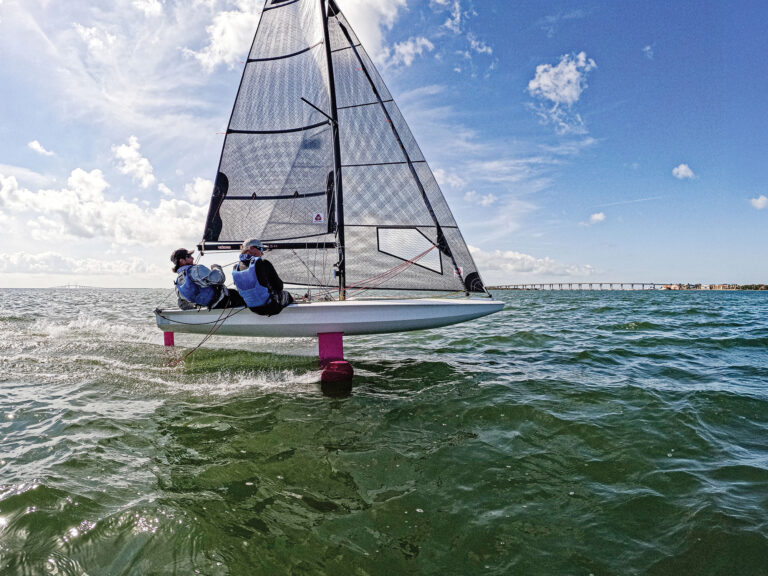
FBRoundTheIsland368
It seems like every region of the country has its equivalent of an “end-of-season” regatta where everyone’s welcome and the point of the exercise is only partially about the actual racing. For the last several years here on Rhode Island’s Narragansett Bay, that event has been Sail Newport’s fund-raising Sail for Hope, a roughly 18-mile loop around Conanicut Island that serves up a veritable smorgasbord of conditions. It’s always a great day for a good cause, and it doesn’t really matter at all how you fare or where you place.
This year, particularly, that’s what I keep telling myself.
That’s because for the 2007 Sail for Hope, which took place a couple of weeks back, I was enlisted to call tactics aboard the 40-footer Amhas, a new Marc Lombard-designed Class 40 yacht recently introduced to the U.S. market by shorthanded sailors Joe Harris and his unrelated partner, Brian Harris. If the boat sounds familiar, I wrote about it in last month’s blog, then shamelessly wrangled myself aboard for the round-the-island race. (Yes, in this case as in others, my ethics and morals have rightfully been called into question; my only defense is that at least I’m honest about it.)
However, my plans for a day of lolling in the sun aboard one of the quickest, coolest entrants in the 75-boat PHRF fleet–with nothing more taxing to do than trim the occasional sail and wait for someone to crack the first beer–were seriously derailed right from the outset, when Joe asked if I’d help out with the tactics. Some might have taken this as a high compliment, an acknowledgement of superior sailing prowess. I knew better. I looked around the boat and realized I was the only Newport homeboy aboard, and pretty much landed the job by local-knowledge default.
My fellow crewmembers, in fact, were an interesting lot, and included a few of the more experienced single- and double-handed sailors in these parts. Along with Joe Harris, who owns and vigorously campaigns the Open 50, Gryphon Solo, there were fellow Bermuda One-Two alumni Mike Mallard and Tristan Mouligne. The former owns the Class 40 yacht, Wildeyes, and the latter won his class and corrected out to first overall in last summer’s singlehanded leg of the One-Two aboard the Freedom 44, Frog Kiss. These are sailors who’ve been attracted to shorthanded sailing, to some extent, for the understandable reason that they’d grown tired of subjecting themselves to the simpleton mistakes of boneheaded shipmates on fully crewed programs.
Nothing I exhibited on the Sail for Hope derailed them from the hard-earned confidence in their convictions.
It was gusting into the low 20s from the northwest as we powered out to the start and hoisted the main, and I was fairly certain the race committee would set us off to windward to tackle the course in a counter-clockwise manner. This was the first of my errors, and regretfully, not the last.
While we were of course hoping to do well overall, our primary focus was on the two other Class 40s in our division, Stuart Williams’ brand-spanking-new Rodger Martin design, Gwaihir, the first 40 conceived and built in the U.S., and Eric Lecoq’s Kamoah, a Finot-designed Pogo production boat.
With a downwind start and a big ebbing tide, I reckoned we should set up by the committee boat with main and jib; jibe immediately onto port and hoist the chute while enjoying clear air, a hot angle, and max current; then jibe back to starboard in the middle of the channel for a nice reach to the mark off Beavertail, where we’d drop the spinnaker and come on the breeze for the long beat up the west side of Conanicut.
Joe had one question, pertaining to the fact that there was a large, black, cruise ship anchored pretty much near the center of the channel. “When we jibe onto port, how’s our angle going to be for clearing the Queen Mary?” he wondered. “Fine,” I said, thinking “only in Newport.”
As it happened, my strategy actually might’ve worked had not the shackle for the spinnaker opened on the hoist, sending the halyard up the mast and pretty much ensuring a white-sail reach to Beavertail. Meanwhile, we watched in envy as Kamoah executed our plan to perfection and were launched downwind to Beavertail. Gwaihir chose an inshore route and that worked out pretty well, too.
In the immortal words of football legend Bill Parcells, when it comes to keeping score, you are what you are. And at Beavertail, we were a distant third among the three 40s, bringing up the rear. Our two rivals chose to short tack along the Conanicut shore for current relief; it didn’t make much sense to follow them, so we split tacks and headed for the opposite shoreline along the mainland. It was there that I enjoyed a brief moment of redemption, as we eventually sneaked ahead of Kamoah and managed to stay there for the eventual run to the finish in fading breeze. In our little race within the race, however, Gwaihir was not to be denied, extending her lead around the track. For now, she’s the Queen of what looks like a growing fleet of Class 40s in the northeast.
Once across the finish line, I dove below for the cooler and the now icy-cold beers. My shipmates and I were finally in agreement: It was easily the best call I’d made all day.









